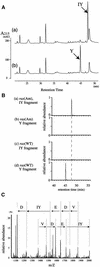Site-specific incorporation of an unnatural amino acid into proteins in mammalian cells
- PMID: 12409460
- PMCID: PMC135798
- DOI: 10.1093/nar/gkf589
Site-specific incorporation of an unnatural amino acid into proteins in mammalian cells
Abstract
A suppressor tRNA(Tyr) and mutant tyrosyl-tRNA synthetase (TyrRS) pair was developed to incorporate 3-iodo-L-tyrosine into proteins in mammalian cells. First, the Escherichia coli suppressor tRNA(Tyr) gene was mutated, at three positions in the D arm, to generate the internal promoter for expression. However, this tRNA, together with the cognate TyrRS, failed to exhibit suppressor activity in mammalian cells. Then, we found that amber suppression can occur with the heterologous pair of E.coli TyrRS and Bacillus stearothermophilus suppressor tRNA(Tyr), which naturally contains the promoter sequence. Furthermore, the efficiency of this suppression was significantly improved when the suppressor tRNA was expressed from a gene cluster, in which the tRNA gene was tandemly repeated nine times in the same direction. For incorporation of 3-iodo-L-tyrosine, its specific E.coli TyrRS variant, TyrRS(V37C195), which we recently created, was expressed in mammalian cells, together with the B.stearothermophilus suppressor tRNA(Tyr), while 3-iodo-L-tyrosine was supplied in the growth medium. 3-Iodo-L-tyrosine was thus incorporated into the proteins at amber positions, with an occupancy of >95%. Finally, we demonstrated conditional 3-iodo-L-tyrosine incorporation, regulated by inducible expression of the TyrRS(V37C195) gene from a tetracycline-regulated promoter.
Figures







References
-
- Brunner J. (1993) New photolabeling and crosslinking methods. Annu. Rev. Biochem., 62, 483–514. - PubMed
-
- Cotton G.J. and Muir,T.W. (1999) Peptide ligation and its application to protein engineering. Chem. Biol., 6, R247–R256. - PubMed
-
- Koide H., Yokoyama,S., Kawai,G., Ha,J., Oka,T., Kawai,S., Miyake,T., Fuwa,T. and Miyazawa,T. (1988) Biosynthesis of a protein containing a nonprotein amino acid by Escherichia coli: l-2-aminohexanoic acid at position 21 in human epidermal growth factor. Proc. Natl Acad. Sci. USA, 85, 6237–6241. - PMC - PubMed
-
- Noren C.J., Anthony-Cahill,S.J., Griffith,M.C. and Schultz,P.G. (1989) A general method for site-specific incorporation of unnatural amino acids into proteins. Science, 244, 182–188. - PubMed
MeSH terms
Substances
LinkOut - more resources
Full Text Sources
Other Literature Sources

